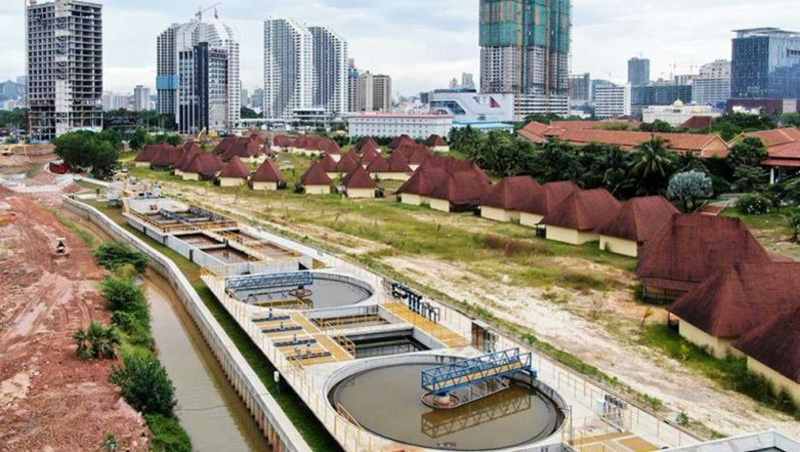
Wastewater treatment stations are seen in Preah Sihanouk Province on Nov. 30.
18:16 JST, December 31, 2021
Cambodia’s public infrastructure is growing by leaps and bounds, with hardly a day going by it seems without another announcement about the completion of a new stretch of road connecting one town to another or a new bridge spanning one of the Kingdom’s rivers in places where they only used to have ferries.
An important part of the big infrastructure push by the Cambodian government has it using its budget and resources on a massive public works upgrade for Preah Sihanouk Province to turn it into a model for the nation — with its multi-purpose special economic zone and its booming Sihanoukville real estate sector standing poised to take off again as the town eagerly awaits the full resumption of international tourism and travel from China.
Five or 10 years ago, Sihanoukville was still a sleepy beach town that mostly relied on low-key domestic and low-cost international tourists with everyone primarily focused on its beautiful beaches. If you had asked anyone what the town was known for they’d have said beaches and then possibly mentioned the colorful local population of eccentric Russians living there.
Today you’d hear words like gambling, casinos, China and, of course, money. Sihanoukville turned into a boomtown pre-pandemic and all indicators point to it returning to one post-pandemic. And what do all of these new high rises and casinos and resorts require? They require a massive amount of new infrastructure.
The need for infrastructure there is urgent and Cambodia’s construction sector has answered the call with an unprecedented number of projects underway by local firms employing local engineers and locally sourced laborers — both skilled and general — with no foreign assistance required.
Prime Minister Hun Sen noticed the trend right from the start and coined the slogan “Built by Khmer” in a speech given while inspecting the progress of the construction of 37 roads on June 1, 2020, in the province.
“When I say ‘Built by Khmer’ that doesn’t just mean having the technical ability to break mountains and build roads. It means that the idea comes from a Khmer mind and the construction is the product of Khmer toil and sweat. All of the design, construction and technical aspects are handled by Khmer. And all of the money paid for it is spent from Khmer bank accounts and paid into Khmer wallets, without any participation whatsoever by foreigners,” he said.
Hun Sen emphasized the slogan once again on Dec. 1, 2021, while inspecting more infrastructure in the province, saying that “Built by Khmer” is an expression of national pride that every generation of Cambodians can celebrate and be a part of.
He further said that he wanted to encourage the younger generations to dream even bigger for the future when imagining what they might accomplish together as Khmer people.
Of course, infrastructure isn’t all as beautiful as Angkor Wat, as exciting as national stadiums or as prominent as friendship bridges. A lot of it is extremely unglamorous while also being extremely necessary.
Take, for example, Preah Sihanouk’s three new wastewater treatment stations equipped with the latest technology from Israel. They are arguably more vital to the success of the city’s development — including its goal of becoming a “smart” city — than some of the much more high profile and visible projects ever will be.
The province’s new wastewater treatment stations will have the combined capacity to treat over 32,000 cubic meters of wastewater per day once construction is completed on the third station. And all three are definitely “Built by Khmer.”
Ly Rith, a 41-year-old Cambodian with a doctorate in engineering from the ENSAM School in Metz, France, headed up the construction of the first two wastewater treatment plants and he was joined by a team of hundreds of Cambodians who filled every job from office secretary to welders and pipe-fitters.
Born in Tany commune’s Bral village of Kampot province’s Angkor Chey district, Rith is now the chairman of the board of directors and the CEO of X-Water Technology Co. Ltd., the company he founded that is the contractor building the stations.
Rith said that he and his team were given a great opportunity by the Cambodian government and he didn’t hesitate to tackle it because he studied and prepared for years and was confident he could get it done with the help of the many talented Khmer with skills in various aspects of construction that he recruited to his team.
Rith points out that Sihanoukville is obviously developing at an unusually rapid pace and as a result the city and the province are now facing many challenges, including the release of large amounts of waste and toxic substances into the environment with harmful impacts on the entire ecosystem and on the tourism value of the province’s beaches.
After studying the situation, the National Committee for Coastal Management and Development of Cambodia — in collaboration with the Preah Sihanouk provincial administration — decided the best way to mitigate the damage was through wastewater treatment stations to clean the run-off from the city before it hits the sea.
This is being done with Israel’s MABR technology, which is internationally recognized as being stable, efficient, energy-saving, noiseless, odorless and harmless to people living in the area near the stations.
Rith said that the words “Built by Khmer” should be applied to all aspects of industry, not just construction, like the production of motors for example. Khmer engineers would first need to design a production chain and acquire the necessary machinery, but very few things that Cambodia really needs are totally impossible for Cambodians to produce today if they have the capital to spend to build the necessary systems.
“I urge all Cambodian engineers … do not hesitate. Do not be afraid. Do not worry about what they say we can’t do. There is nothing we cannot do. We’ve learned to be engineers and engineers design products and we can too,” he said.
He added that among the hundreds of components that went into building the subsystems for the wastewater treatment stations, less than 1% were faulty or needed to be adjusted or replaced after assembly and testing.
Rith explained that when it comes to accomplishing practical work with a team of Cambodians, the Cambodian engineers actually have a big advantage over foreign engineers because most people are more comfortable communicating in their native language and there’s a level of understanding reached that even the best second-language English speakers rarely achieve.
Not only that, but the Cambodian engineers cost a lot less than the foreigners do — for now, anyway.
Rith says he is committed to continuing to work with the Cambodian government to build more of these wastewater treatment stations in the capital and in other provinces to help preserve the environment and raise the standard of living for all Cambodians by eliminating pollution with projects that can proudly advertise: “Built by Khmer.”
He recounted how Khmer had built Angkor Wat and all of Cambodia’s other magnificent temples. Thus, the slogan “Built by Khmer” that he was using in Preah Sihanouk and across the Kingdom was meant to put an appropriate emphasis on national achievements along these lines as the foundation for Cambodia’s cultural heritage.
He said that designing wastewater treatment station systems was more difficult than designing most things the average engineer encounters in the course of their career, but he has an ambitious team who were determined to do the job with confidence instead of fear.
"World" POPULAR ARTICLE
-

8 Japanese Nationals Stranded on Indonesia’s Sumatra Island
-

Mozambican Cooking Class Held in Matsuyama, Ehime Pref.; Participants Don Aprons, Bandanas Made from Traditional Mozambique Fabric
-

China to Impose Sanctions on Shigeru Iwasaki, Former Head of Japan’s Self-Defense Forces, Who Serves as Adviser to Taiwan’s Executive Branch
-

China Steps Up ‘Wolf Warrior’ Diplomacy Against Japan, Hurling Accusation About Plutonium Stockpile
-

U.S. Senate Resolution Backs Japan, Condemns China’s Pressure
JN ACCESS RANKING
-

Keidanren Chairman Yoshinobu Tsutsui Visits Kashiwazaki-Kariwa Nuclear Power Plant; Inspects New Emergency Safety System
-

Imports of Rare Earths from China Facing Delays, May Be Caused by Deterioration of Japan-China Relations
-

University of Tokyo Professor Discusses Japanese Economic Security in Interview Ahead of Forum
-

Japan Pulls out of Vietnam Nuclear Project, Complicating Hanoi’s Power Plans
-

Govt Aims to Expand NISA Program Lineup, Abolish Age Restriction






















